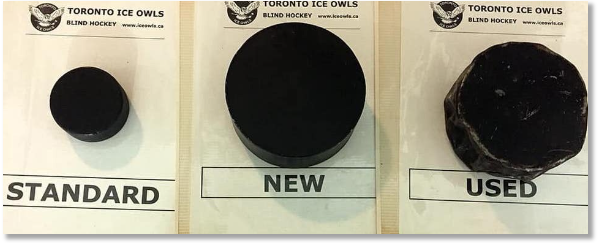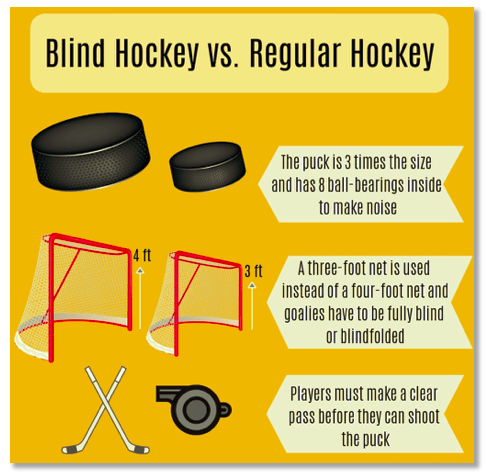The Game
About blind hockey
The parasport of Blind Hockey is a variation of ice hockey for athletes who are blind or partially sighted. The sport uses some modified rules and equipment, most notably the adapted puck that makes noise and is larger than a traditional puck. At the recreational level all athletes must be visually impaired, while at the competitive level all players must be classified as legally blind, which is defined as having approximately ten percent vision or less. While there is no rule limiting where a skater may or may not go on the ice, typically skaters with the most vision play forward and participate in all three zones, while skaters with less vision or no vision will play defence. In some cases, players with very little or no vision play the role of a true stay-at-home defenseman by participating only in their own end while communicating with their goalie to orient themselves on the ice. All goaltenders are extremely low vision or completely blind and wear a blindfold.
Adapted puck

A traditional hockey puck measures three inches across and one inch high, while the adapted puck for Blind Hockey measures five and a half inches across by one and two-thirds of an inch high. A traditional puck is constructed out of rubber, is solid, and makes no noise. A Blind Hockey puck is constructed out of thin steel, is hollow, and contains ball bearings which rattle around and make noise. The larger size and sound allow blind and partially sighted players to track its location as it moves around the ice, and it is the single most important adaptation that makes ice hockey accessible to athletes who are blind or partially sighted.
Adapted rules: “pass rule”
Blind Hockey vs Regular Hockey - The most significant adaptation to the rules of traditional ice hockey is the “Pass Rule.” The “Pass Rule” dictates that an attacking team must complete at least one pass after they cross the offensive blue line before they are eligible to score. Once the “Pass Rule” has been completed, the referee will sound an electronic whistle that emits a distinct high-pitched chirping noise. The sound of the pass whistle indicates to the offensive players that they are now eligible to attempt to score, while simultaneously alerting the defensive players and goaltender that a shot may be coming.
This rule is especially important to make the sport accessible to players who are completely blind: especially the goaltenders. The “Pass Rule” remains completed and the attacking team remains eligible to score until the puck either leaves the zone or play is stopped for any reason. If the puck leaves the zone or the play is stopped resulting in a face-off, the attacking team would once again be required to make a minimum of one pass in the attacking zone before being eligible to score. This rule has many benefits including stopping the players with the most vision and highest skill from simply dominating games while constantly rushing end to end and scoring goals on unsuspecting goaltenders. There are no breakaways in the sport of Blind Hockey, it is truly a team game!
Adapted rules: modified nets, goaltender rules and crease restrictions
Blind ice hockey goalie - The other major significant adaptations all have to do with the goaltenders as they are playing hockey’s most important position while completely blind or blindfolded, against players who see significantly more. Since the pucks do not make much noise in the air, the sport of Blind Hockey uses modified three-foot-high nets, which are one foot shorter than traditional nets which are four-foot-height.
In instances of recreational play or practice where custom Blind Hockey nets are not available, the sport uses a “Shot Blocker” which is a tarp (usually made from canvas or strong plastic) that attaches to the net (usually by either velcro straps or bungy cord) and covers the top foot of the traditional net.
The Blind Hockey puck does not make any noise when completely still, as such Blind Hockey goalies do not need to worry about covering it to stop play so long as it remains in the crease after they make a save. Instead, if the puck comes to a complete stop in the crease after the goaltender has made a save, it is declared frozen and the play is stopped immediately.
For safety reasons, no player on either team other than the goaltender is ever allowed to enter the crease, and the sport uses all standard International Ice Hockey Federation (IIHF) safety protocols including crease violations, no touch icing, and stopping the play anytime a goaltender is hit in the head with the puck.

Blind Hockey vs Regular Hockey long description
- The puck is 3 times the size and has 8 ball-bearings inside to make nose
- A three-foot net is used instead of a four-foot net and goalies have to be fully blind or blindfolded
- Players must make a clear pass before they can shoot the puck
 Toronto Ice Owls
Toronto Ice Owls